Welcome
to the McGill Bird Observatory weekly report.
Click here for a complete listing of our archives.
Comments or
questions are welcome at "mbo AT migrationresearch.org".
|
PICTURE
OF THE WEEK: |
|
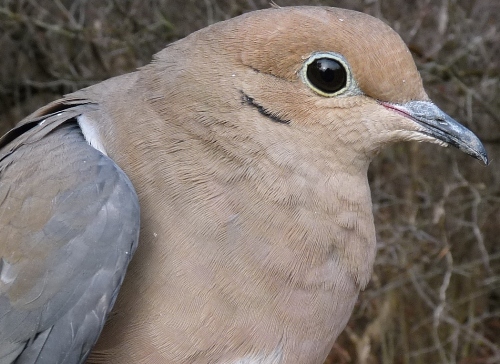
Although Mourning Doves are present at MBO throughout the year, we only ever
catch them during winter. This individual was the first we banded in nearly three
years, but several more followed later in the month.
(Photo by Marcel Gahbauer)

|
MBO
gratefully acknowledges the in-kind support provided for winter 2009-2010 by CCFA (Centre de Conservation de la Faune Ailée) in Montreal, in the form of bird seed to keep the MBO feeders stocked throughout the season.
|
|
|
|
THIS PERIOD |
THIS WINTER |
2009 TOTAL |
SITE TOTAL |
|
# birds (and species) banded |
157 (13) |
185 (14) |
4579 (86) |
23500 (105) |
|
# birds (and species) repeat |
74 (8) |
89 (10) |
974 (51) |
4321 (66) |
|
# birds (and species) return |
5 (3) |
6 (4) |
166 (32) |
620 (37) |
|
# species observed |
40 |
48 |
166 |
199 |
|
# net hours |
85.0 |
242.0 |
9437.9 |
39903.2 |
|
# birds banded / 100 net hours |
184.7 |
76.4 |
48.4 |
58.9 |
|
|
Note: table does not include nocturnal banding (owls) |
|
Banders-in-charge: Simon Duval, Marcel Gahbauer, Gay Gruner
Assistants: Nicki Fleming, Alain Goulet, Marie-Anne Hudson, James Junda, Kristen Keyes, Barbara and Don MacDuff
Notes: This year we continued with our fall banding setup into the first week of November, but the results were rather poor in terms of banding. That period was featured in our previous report, while this one covers the rest of the month, during which we operated at our more traditional winter setup around the feeders.
Not surprisingly, capture rate was substantially higher around the feeders. One of the aims of banding frequently early in winter is to mark the population of locally wintering birds so that we can track their occurrence throughout the season. We had five banding sessions between November 15 and 29, with the number of new captures ranging from 23 to 44 each time. Over time we expect the number of new captures to decline as recaptures become more frequent, but we still had 36 new birds on Nov 29, indicating that we are far from having marked the whole population using the MBO feeders.
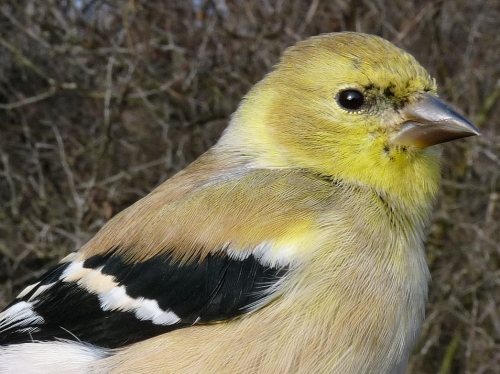
American Goldfinches were abundant this month, with all age and sex classes well represented. Some of the adult males were particularly colourful, including this one with a distinctly yellow head and even flecks of black on the forehead.
(Photo by Marcel Gahbauer)
|
American Goldfinches and Slate-coloured Juncos dominated this month, with House Finches not far behind. Both House Finches and Mourning Doves were banded for the first time in three years, and in considerable abundance, with the totals for the month higher than two of three previous full winter seasons ... and plenty of unbanded individuals still around at the end of the month. We also recaptured a female House Finch banded at MBO in December 2006, suggesting some site fidelity. The number of Slate-coloured Juncos banded suggests that migrants were still arriving in November, whereas only a small minority of the Black-capped Chickadees caught were unbanded. Surprises at the net included American Robin and Red-winged Blackbird - not only late in the year, but typically not associated with feeders.
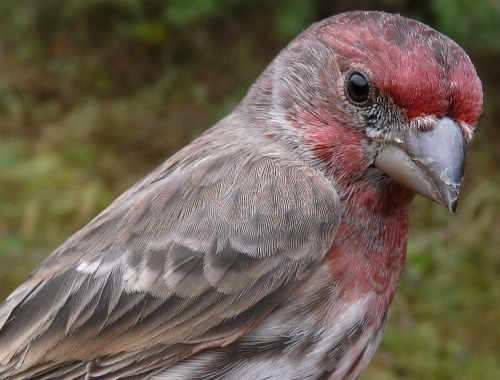
This month we banded House Finches for the first time in three years, and a good number of them at that. Among them were several very bright hatch-year males, including this one. Its age was given away by its wing (photo below), showing a distinct contrast between the primary and greater coverts, and also an eccentric moult limit among the primaries - the innermost four retained, contrasting with the darker and fresher outer primaries.
(Photos by Marcel Gahbauer)
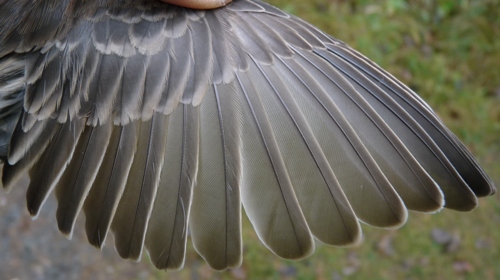
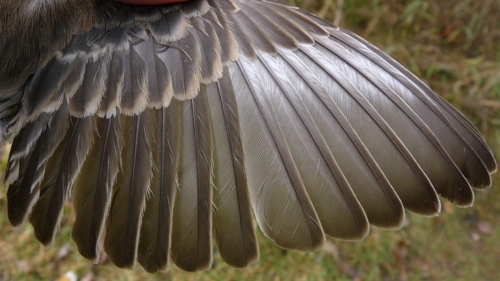
Another House Finch we caught in November showed this interesting white patch on both wings.
(Photo by Marcel Gahbauer)
|
Usually in winter we don't post a table of the most frequently banded and observed species like we do during migration, but we had such an active month this time that it's worth including it for the sake of comparison with late fall data. The banding list is topped by our five most numerous feeder visitors, though the Black-capped Chickadees are under-represented as most of the local population has been previously banded. Once the corn in the adjacent field was cut in the second week of November, the Canada Geese took advantage, with as many as 800 present there one morning. Mallard and American Crow numbers increased too, albeit not as drastically. Ranked fourth through eighth are the dominant species at the feeders this month. Chickadee counts have ranged as high as 40 individuals, while top counts for the others are 38 for American Goldfinch, 28 for Slate-coloured Junco, 36 for Mourning Dove, and 28 for House Finch. The Mourning Dove numbers are particularly impressive as we have not seen such numbers since 2005. Whereas their numbers were already growing a couple of weeks before we put the feeders up, the House Finches seem to have arrived in direct response to our offerings.
This week’s top 10 [last week's rank in brackets]
# individuals banded |
mean # individuals observed daily |
1. American Goldfinch (56) [-] |
1. Canada Goose (161) [3] |
2. Slate-coloured Junco (35) [1] |
2. American Crow (67) [5] |
3. House Finch (31) [-] |
3. Mallard (30) [8] |
4. Mourning Dove (10) [-] |
4. Black-capped Chickadee (19) [7] |
5. Black-capped Chickadee (6) [2] |
5. American Goldfinch (17) [6] |
6. American Tree Sparrow (5) [4] |
6. Slate-coloured Junco (15) [3] |
7. American Robin (4) [6] |
7. Mourning Dove (14) [-] |
8. Fox Sparrow (3) [3] |
8. House Finch (10) [-] |
8. White-throated Sparrow (3) [4] |
9. American Robin (9) [2] |
10. Four species tied (1) |
10. Blue Jay (6) [-] |
|
Out of the 40 species observed between November 7 and 30, 17 were recorded on just one of our 12 visits: Cackling Goose, Herring Gull, Great Black-backed Gull, Rock Pigeon, Peregrine Falcon, Pileated Woodpecker, Common Raven, Red-breasted Nuthatch, Brown Creeper, Carolina Wren, Townsend's Solitaire, Gray Catbird, Cedar Waxwing, Bohemian Waxwing, Common Grackle, Pine Siskin, and House Sparrow. Some of these sightings are of special note. Great Black-backed Gull is a rare species at MBO, and the flock of 11 that flew over on November 29 was a new high count for the site. The Carolina Wren was only the second record for the site, while the Townsend's Solitaire was almost certainly the same bird first spotted on the final day of the fall program. The Gray Catbird on November 15 set a new record late for MBO, and was not likely one of the local birds, as none had been seen for a few weeks previous to this sighting. The fact that over 40% of species during this period were observed on a single day suggests there is good value in continuing census and other observations as frequently as possible in winter!
|
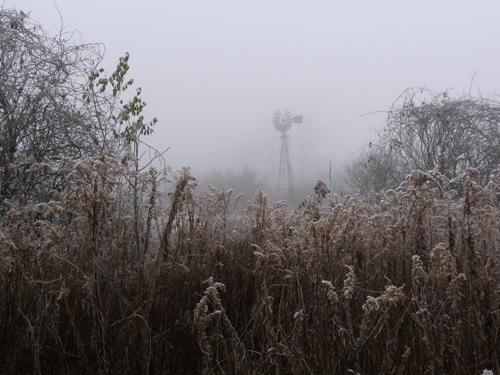
A beautiful frosty morning in late November, looking toward the old windmill from near the feeders.
(Photos by Marcel Gahbauer)
|







